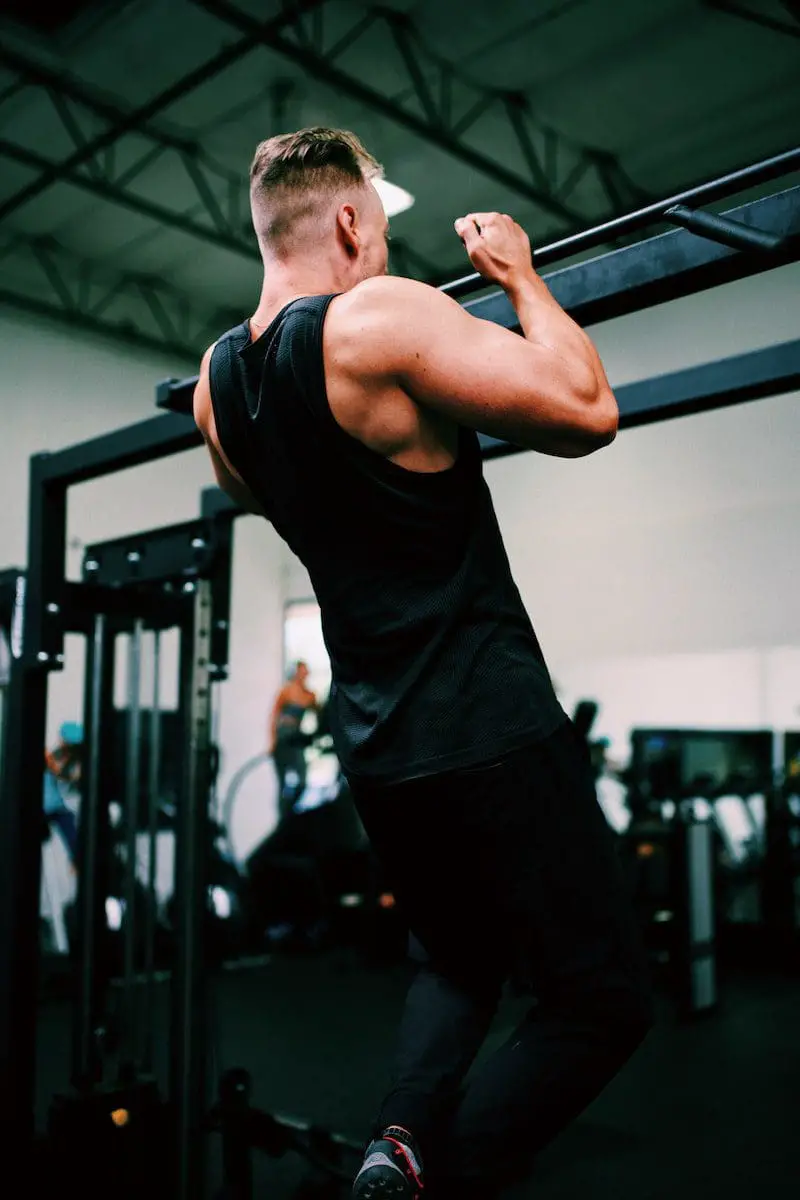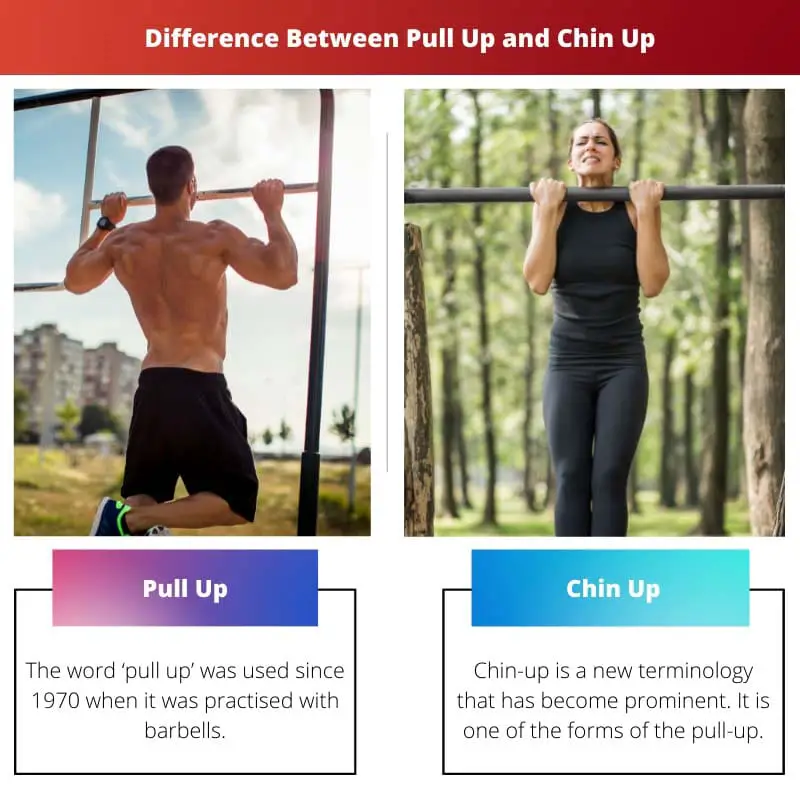Exercise is considered very important for the overall development of the body. It is a physical activity that maintains wellness and keeps our body fit.
Exercise is done for various purposes to develop muscles, improve strength, improve health, for athletics, or simply for enjoyment.
Many people like to exercise in outdoor situations because they interact, and socialize in groups which helps them m to enhance their wellness. Pull Up and Chin Up are muscular exercises.
Key Takeaways
- Pull-ups use a pronated (overhand) grip, while chin-ups use a supinated (underhand) grip.
- Pull-ups primarily target the latissimus dorsi muscles, while chin-ups engage more biceps and chest muscles.
- Chin-ups are easier due to the greater engagement of the biceps and chest muscles.
Pull Up vs Chin Up
A pull-up is an exercise that involves gripping a horizontal bar with an overhand grip (palms facing away from the body) and pulling the body up until the chin reaches or passes the bar. A chin-up is an exercise that involves gripping a horizontal bar with an underhand grip (palms facing towards the body) and pulling the body up until the chin passes the bar.

Pull Up exercise is called a Closed Kinetic Chain exercise because in this exercise, hands and feet are fixed in one position in space, and they can’t be moved.
In this exercise, upper body strength is required to push the body upwards. Shoulders abduct, elbows are flexed and then extended to bring them into the torso.
Pull up uses muscles such as the biceps brachii and latissimus dorsi.
Chin-up exercise is done to strengthen the muscle, which helps in extending shoulders and flexing elbows. While doing a chin-up, palms should be facing towards the body.
It is one of the forms of pull-up only where the body is taken up to the chin, i.e. name chin-up is given. The main target of chin-up is to make the biceps which makes it different from pull-up.
Comparison Table
| Parameters of Comparison | Pull Up | Chin Up |
|---|---|---|
| Best For | building upper back, achieving the V-shape | strengthening the lats and biceps and sculpting big arms. |
| Grip | Pronated | Supinated |
| Trap Activation | Better | Worst |
| Biceps Activation | Worst | Better |
| Muscle | lats, teres major, rhomboids, biceps, core | biceps, lats, forearm, shoulders, core |
What is Pull Up?
The word ‘pull up’ has been used since 1970 when it was practised with barbells. It is also called an open-chain pulling exercise.
Now in modern-day, it is popularly known as upright row and bent-over row.
Pulls ups are pronated, which means that palms are facing away, and the Guinness World Record have even made a distinction between pull up and chin according to the grip.
Pull up is always used to test the upper physical strength of the body. This type of exercise is more common in military services because there is a test for it to check the fitness of the body.
In many parts of the world, pull-ups are used in military tests according to various norms.
There are different types of variations in doing pull-ups like Standard, Weighted, mixed-grip, one arm, one hand, kipping, sternum chins, muscle up, supine row etc.
Muscles of various parts of the body are used, such as elbows, shoulders, scapula, and finger, through which adduction, extension, and isometric flexion takes place. Deltoid, Pectoralis major, Infraspinatus,
Teres minor, Teres major etc., are responsible. Grip plays a very important role while holding and grabbing the bar.
The width of the grip also varies according to the type of pull up an individual does.

What is Chin Up?
The chin-up is a new terminology that has become prominent. It is one of the forms of the pull-up.
Name chin-up comes from how you can bring your chin in relation to the position of the bar or the grip with which you are holding the bar. In this exercise, an individual has to bring the chin over the bar without touching it.
The exercises performed in chin-ups help in the extension of the biceps. Men can easily do chin-ups than women because they have stronger biceps and a centre of gravity. It is the general view.
But it doesn’t mean that chin-up cannot be done by women. It can be achieved by supinated, i.e. palm facing towards the grip. Chin-ups have various forms. They can be done using gymnastic rings, rotating handles or barbells.
Chin-up’s main target is the biceps, and it also uses muscles like the latissimus dorsi muscle. There are variations in chin-ups like weighted chin-ups, one-hand chin-ups, one-arm chin-ups, spine chin-ups, sternal chin-ups etc.
A special type of training is required to do chin-up exercises. It also helps in increasing your performance.
It is measured in different ways, such as the number of repetitions in a specified time interval, the number of repetitions with a total weight (body weight+ additional weight and the number of repetitions without touching the floor.
Bars in which chin-ups are installed in playgrounds as well for children so that they can make their bodies fit.

Main Differences Between Pull Up and Chin Up
- Pull Up is best for building the upper back and achieving the coveted V-shape, as it is concerned with upper body strength. The chin-up is best for making your arms big, especially for the biceps and lats.
- Grip in a pull-up is pronated, i.e. palm is facing away. Grips in chin up are supinated, i.e. palms are facing towards.
- Pull Up has a better trap activation. Chin-up has the worst trap activation.
- Pull-up has the worst bicep activation. Chin-up has better biceps activation as its main target is to strengthen the biceps.
- Muscles involved in pull-ups are lats, teres major, rhomboids, biceps, core etc. Muscles involved in chin-ups are biceps, lats, forearm, shoulders, core etc.

- https://search.proquest.com/openview/118f44a7b35e76ad252aa5a557e70197/1?pq-origsite=gscholar&cbl=4718
- https://www.tandfonline.com/doi/abs/10.1207/S15327841MPEE0502_1

The detailed information about the muscles utilized and the physiological impact of chin-ups is very educational.
The diverse forms of chin-ups and the training options they offer are presented in a very engaging manner.
The gender aspect and the biomechanics of chin-ups provide an interesting perspective on these exercises.
The comparison table is very useful in understanding the different parameters for pull-ups and chin-ups.
I agree, the detailed explanation of the grip and muscle activation is quite enlightening.
I appreciate the focus on the biomechanics of the exercises, it really sheds light on their effectiveness.
The focus on the kinetic chain properties of pull-ups and the mechanics of the exercises is quite insightful.
Agreed, the concept of closed kinetic chain exercises and their impact on upper body strength is explained very well.
The historical references to the origins and the modern evolution of pull-ups are an intriguing addition to the article.
The variations and detailed explanations about pull-ups are quite remarkable and provide a comprehensive understanding.
The inclusion of military use and testing of pull-ups provides a unique societal context to these exercises.
I appreciate the biological and physiological details provided about the impact of these exercises on different muscles.
The mention of the different grip variations for pull-ups is quite intriguing and worth exploring further.
Agreed, the information about the various muscles involved and their role is quite insightful.
I found this article to be very informative and helpful in understanding the differences between pull-ups and chin-ups.
The comprehensive nature of this article, covering historical, biomechanical, and training aspects, makes it a valuable resource for anyone interested in pull-ups and chin-ups.
Agreed, the multitude of information provided here gives a holistic perspective on these exercises and their variations.
This article presents a comprehensive overview of pull-ups and chin-ups, which is beneficial for anyone interested in these exercises.
The explanation of the differences in grips and targeted muscles between pull-ups and chin-ups is very educational.
The emphasis on gender differences and the ability to perform chin-ups is an interesting perspective to consider.
The diversity of pull-up variations described in the article is impressive and provides plenty of options for training.
The historical context of pull-ups and chin-ups adds depth to the understanding of these exercises.
It’s fascinating to learn about the origins and evolution of these exercises over time.